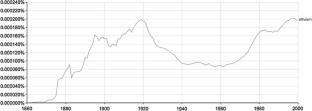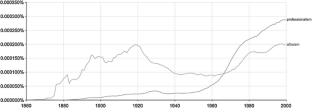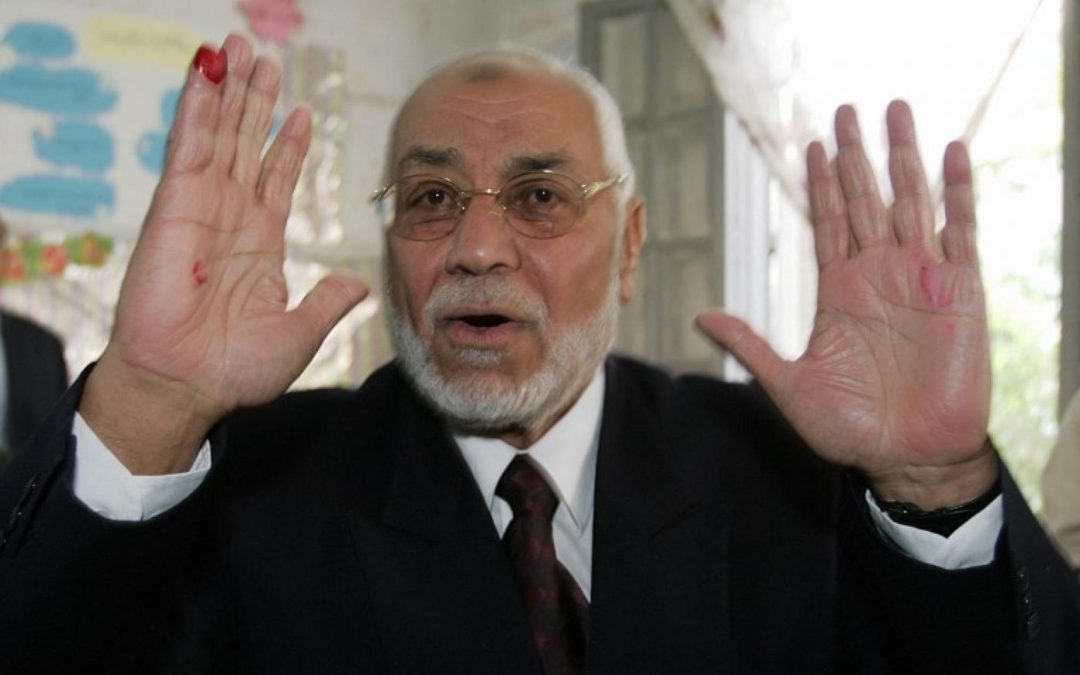Abstract
As an ideal, altruism has long enjoyed privileged status in medicine and medical education. As a practice, altruism is perceived to be in decline in the current generation. A number of educational efforts are underway to reclaim this “lost value” of medicine. In this paper we explore constructions of altruism over a defined period of time through a content analysis of the Canadian and Australian Medical Associations (CMA and AMA respectively) Codes of Ethics. We analyzed all editions of both Codes (1868–2004), using a content analysis approach, including thematic analysis. We coded as altruistic or non-altruistic, respectively, statements in which the interest of the patient is placed ahead of the physician’s and statements in which the interest of the physician is given primacy. We examined the pattern of appearance and disappearance of these statements over time. We identified 13 altruistic and 2 non-altruistic statements across all editions. There is a gradual and uneven loss of altruistic content over time. The CMA Codes of 1938, 1970 and 2004 and the AMA code of 1992 represent significant change points. The most recent versions of both Codes contain only 1 altruistic statement and both non-altruistic statements. We conclude that altruism appears to be a fluid and changing concept over time. Loss of altruism is not merely a current generational issue but extends through the past century and is likely due to political and social forces. These results call into question current educational attempts to reclaim altruism, and point to the social evolution of the ideal.


References
-
Abbasi, K. (2013). Idealism, the lost spirit of medicine. Journal of the Royal Society of Medicine, 106, 343. doi:10.1177/0141076813501787.
-
Accreditation Council for Graduate Medical Education. (2005). The ACGME outcome project, 2005. Retrieved January 19, 2016, from www.acgme.org/Outcome/Comp/compFullAsp
-
American Board of Internal Medicine Foundation, American College of Physicians-American Society of Internal Medicine, et al. (2002). Medical professionalism in the new millennium: A physician charter. Annals of Internal Medicine, 136, 243–246.
-
American Medical Association. (1964). American Medical Association code of ethics. Retrieved January 19, 2016, from http://www.ama-assn.org/ama/pub/about-ama/our-history/history-ama-ethics.page
-
Angell, M., Kassirer, J. P., & Relman, A. S. (2000). Looking back on the millennium in medicine [editorial]. The New England Journal of Medicine, 342(1), 42–49.
-
Baddock, K. (2013). Altruism will survive the new professionalism in general practice: No. Journal of Primary Health Care, 5, 251–252.
-
Baker, R., & Emanuel, L. (2000). The efficacy of professional ethics: The AMA Code of Ethics in historical and current perspective. The Hastings Centre Report, 30, S13–S17.
-
Bishop, J. P., & Rees, C. E. (2007). Hero or has-been: Is there a future for altruism in medical education? Advances in Health Sciences Education: Theory and Practice, 12, 391–399.
-
Burks, D. J., & Kobus, A. M. (2012). The legacy of altruism in health care: The promotion of empathy, prosociality and humanism. Medical Education, 46, 317–325.
-
Canadian Medical Association. (1868). Canadian Medical Association code of ethics. Retrieved January 19, 2016, from http://www.royalcollege.ca/portal/page/portal/rc/common/documents/bioethics/primers/medical_ethics/CMACodeofEthics1868.pdf
-
Canadian Medical Association. (1970a). Proceedings of the 103rd Annual Meeting of the Canadian Medical Association. Paper presented at the 103rd Annual Meeting of the Canadian Medical Association, Winnipeg
-
Canadian Medical Association. (1970b). Canadian Medical Association code of ethics. Retrieved January 19, 2016, from http://www.royalcollege.ca/portal/page/portal/rc/common/documents/bioethics/primers/medical_ethics/CMACodeofEthics1970.pdf
-
Canadian Medical Association. (1996). Canadian Medical Association code of ethics. Retrieved January 19, 2016, from http://www.royalcollege.ca/portal/page/portal/rc/common/documents/bioethics/primers/medical_ethics/CMACodeofEthics1996.pdf
-
Canadian Medical Association. (2004). Canadian Medical Association code of ethics. Retrieved January 19, 2016, from http://policybase.cma.ca/dbtw-wpd/PolicyPDF/PD04-06.pdf
-
Canadian Medical Association. (2014). Canadian Medical Association Annual Meeting and General Council. Retrieved January 19, 2016, from https://www.cma.ca/En/Pages/gc-annual-meeting.aspx
-
Canadian Medical Association Journal. (2006). Is medicine still a profession? Canadian Medical Association Journal, 174, 743–745. doi:10.1503/cmaj.060248.
-
Chandratilake, M., McAleer, S., et al. (2012). Cultural similarities and differences in medical professionalism: A multi-region study. Medical Education, 46, 257–266.
-
Cohen, J. (2004). Containing the threat—don’t forget Ebola. PLoS Medicine, 1, e59.
-
Collier, R. (2011). American Medical Association membership woes continue. Canadian Medical Association Journal, 183, E713–E714.
-
Crawshaw, R., & Link, C. (1996). Evolution of form and circumstance in medical oaths. The Western Journal of Medicine, 164, 452–456.
-
DiMaggio, P., & Powell, W. W. (1983). The iron cage revisited: Collective rationality and institutional isomorphism in organizational fields. American Sociological Review, 48, 147–160.
-
Flexner, A., et al. (1910). Medical education in the United States and Canada; a report to the Carnegie Foundation for the Advancement of Teaching. New York: Carnegie Foundation.
-
Frank, J. R. (2005). The CanMEDS 2005 physician competency framework: Better standards, better physicians, better care. Ottawa: Royal College of Physicians and Surgeons of Canada.
-
Gillon, R. (2000). White coat ceremonies for new medical students. Journal of Medical Ethics, 26, 83–84.
-
Hafferty, F. W. (2006). Measuring professionalism: A commentary. In D. T. Stern (Ed.), Measuring medical professionalism (p. xv). New York : Oxford University Press.
-
Hafferty, F. W., & Castellani, B. (2010). The increasing complexities of professionalism. Academic Medicine, 85, 288–301.
-
Hodges, B. D., & Segouin, C. (2008). Medical education: It’s time for a transatlantic dialogue. Medical Education, 42, 2–3.
-
Hurwitz, B., & Richardson, R. (1997). Swearing to care: The resurgence in medical oaths. British Medical Journal, 315, 1671–1674.
-
Jones, R. (2002). Declining altruism in medicine. British Medical Journal, 324, 624–625.
-
Kao, A. C., & Parsi, K. P. (2004). Content analyses of oaths administered at US medical schools in 2000. Academic Medicine, 79, 882–887.
-
Kenrick, D. T. (1991). Proximate altruism and ultimate selfishness. Psychological Inquiry, 2, 135–137.
-
Kluge, E. H. (1992). Codes of ethics and other illusions. Canadian Medical Association Journal, 146, 1234–1235.
-
Krippendorff, K. (2004). Content analysis: An introduction to its methodology (2nd ed.). Thousand Oaks, CA: Sage.
-
Listed, N. A. (1999). Learning objectives for medical student education—guidelines for medical schools: Report I of the Medical School Objectives Project. Academic Medixine, 74, 13–18.
-
Ludmerer, K. M. (2011). Abraham Flexner and medical education. Perspectives in Biology and Medicine, 54, 8–16.
-
Merritt Hawkins and Associates. (2007). Survey of physicians 50–65 years old. Summary report. Retrieved January 19, 2016, from http://www.merritthawkins.com/pdf/mha2007olderdocsurvey.pdf
-
Meyer, J. W., & Rowan, B. (1977). Institutionalized organizations: Formal structure as myth and ceremony. American Journal of Sociology, 83(2), 340–363.
-
Michel, J. B., Shen, Y. K., et al. (2011). Quantitative analysis of culture using millions of digitized books. Science, 331, 176–182.
-
Naylor, C. D. (1981). The CMA’s first code of ethics: medical morality or borrowed ideology? Journal of Canadian studies. Revue d’Etudes Canadiennes, 17, 20–32.
-
Nichols, B. G., Nichols, L. M., et al. (2014). Operationalizing professionalism: A meaningful and practical integration for resident education. Laryngoscope, 124, 110–115.
-
Nowak, M. A. (2006). Five rules for the evolution of cooperation. Science, 314, 1560–1563.
-
Osmun, T. (1999). Angels, doctors and public perceptions. Canadian Medical Association Journal, 161, 1507–1508.
-
Ricard, M. (2015). Altruism: The power of compassion to change yourself and the world (1st North American edition). New York, NY: Little, Brown and Co.
-
Riddick, F. A., Jr. (2003). The code of medical ethics of the american medical association. Ochsner Journal, 5, 6–10.
-
Smith, J. M. (1964). Group selection and kin selection. Nature, 201, 1145–1147.
-
Somerville, M. A., & Saul, J. R. (1999). Do we care?: Renewing Canada’s commitment to health: Proceedings of the First Directions for Canadian Health Care Conference. Montreal QC: McGill-Queen’s University Press.
-
Sritharan, K., Russell, G., et al. (2001). Medical oaths and declarations. British Medical Journal, 323, 1440–1441.
-
Steinberg, D. (2010). Altruism in medicine: Its definition, nature, and dilemmas. Cambridge Quarterly of Healthcare Ethics, 19, 249–257.
-
Wakefield, J. C. (1993). Is altruism part of human nature? Toward a theoretical foundation for the helping professions. Social Service Review, 67(3), 406–458.
-
Wear, D., & Aultman, J. M. (2006). Professionalism in medicine: Critical perspectives. New York, NY: Springer.
-
Williams, J. R. (1994). Revision of the Code of Ethics: a backgrounder for the CMA annual meeting. Canadian Medical Association Journal, 151, 209–210.
-
Zardo, P., & Collie, A. (2014). Measuring use of research evidence in public health policy: A policy content analysis. BMC Public Health, 14, 496.
Acknowledgments
Lorelei Lingard is supported as a scientist in the Program of Experimental Medicine in the Department of Medicine at the Schulich School of Medicine and Dentistry, Western University.
Ethics declarations
Conflict of interest
None.
Cite this article
Haddara, W., Lingard, L. Exploring the premise of lost altruism: content analysis of two codes of ethics. Adv in Health Sci Educ 22, 839–852 (2017). https://doi.org/10.1007/s10459-016-9713-6
-
Received:
-
Accepted:
-
Published:
-
Issue Date:
Keywords
- Altruism
- Medical education
- Codes of ethics

